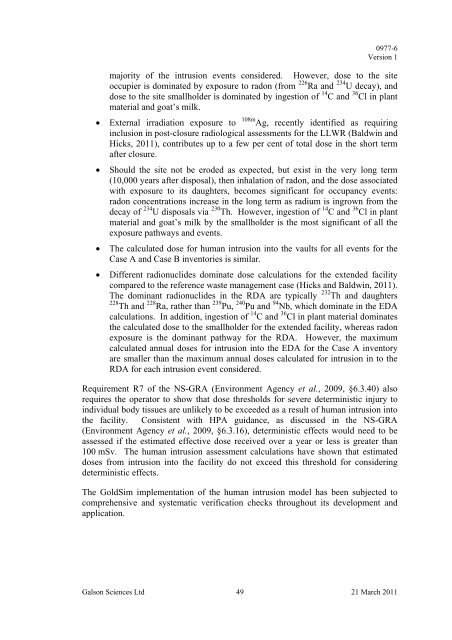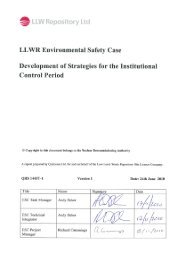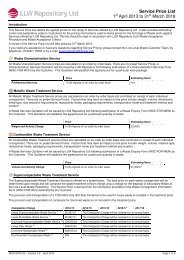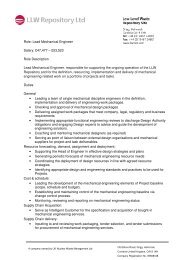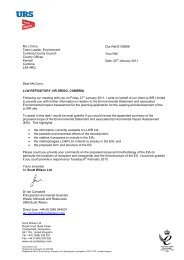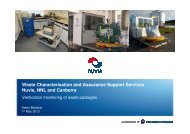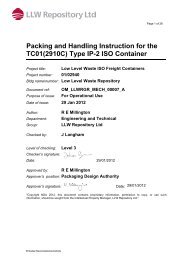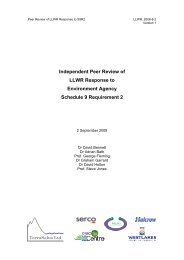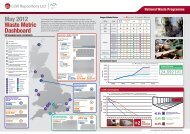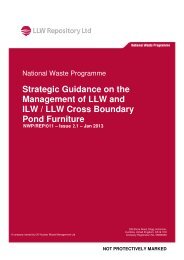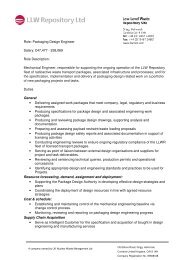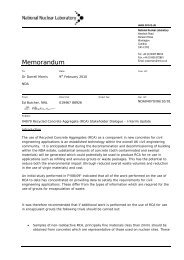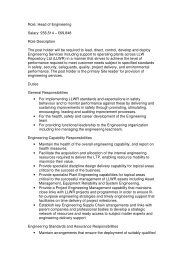Baldwin TD and Hicks TW, Assessment Calculations for Human ...
Baldwin TD and Hicks TW, Assessment Calculations for Human ...
Baldwin TD and Hicks TW, Assessment Calculations for Human ...
You also want an ePaper? Increase the reach of your titles
YUMPU automatically turns print PDFs into web optimized ePapers that Google loves.
0977-6Version 1majority of the intrusion events considered. However, dose to the siteoccupier is dominated by exposure to radon (from 226 Ra <strong>and</strong> 234 U decay), <strong>and</strong>dose to the site smallholder is dominated by ingestion of 14 C <strong>and</strong> 36 Cl in plantmaterial <strong>and</strong> goat’s milk.• External irradiation exposure to 108m Ag, recently identified as requiringinclusion in post-closure radiological assessments <strong>for</strong> the LLWR (<strong>Baldwin</strong> <strong>and</strong><strong>Hicks</strong>, 2011), contributes up to a few per cent of total dose in the short termafter closure.• Should the site not be eroded as expected, but exist in the very long term(10,000 years after disposal), then inhalation of radon, <strong>and</strong> the dose associatedwith exposure to its daughters, becomes significant <strong>for</strong> occupancy events:radon concentrations increase in the long term as radium is ingrown from thedecay of 234 U disposals via 230 Th. However, ingestion of 14 C <strong>and</strong> 36 Cl in plantmaterial <strong>and</strong> goat’s milk by the smallholder is the most significant of all theexposure pathways <strong>and</strong> events.• The calculated dose <strong>for</strong> human intrusion into the vaults <strong>for</strong> all events <strong>for</strong> theCase A <strong>and</strong> Case B inventories is similar.• Different radionuclides dominate dose calculations <strong>for</strong> the extended facilitycompared to the reference waste management case (<strong>Hicks</strong> <strong>and</strong> <strong>Baldwin</strong>, 2011).The dominant radionuclides in the RDA are typically 232 Th <strong>and</strong> daughters228 Th <strong>and</strong> 228 Ra, rather than 239 Pu, 240 Pu <strong>and</strong> 94 Nb, which dominate in the EDAcalculations. In addition, ingestion of 14 C <strong>and</strong> 36 Cl in plant material dominatesthe calculated dose to the smallholder <strong>for</strong> the extended facility, whereas radonexposure is the dominant pathway <strong>for</strong> the RDA. However, the maximumcalculated annual doses <strong>for</strong> intrusion into the EDA <strong>for</strong> the Case A inventoryare smaller than the maximum annual doses calculated <strong>for</strong> intrusion in to theRDA <strong>for</strong> each intrusion event considered.Requirement R7 of the NS-GRA (Environment Agency et al., 2009, §6.3.40) alsorequires the operator to show that dose thresholds <strong>for</strong> severe deterministic injury toindividual body tissues are unlikely to be exceeded as a result of human intrusion intothe facility. Consistent with HPA guidance, as discussed in the NS-GRA(Environment Agency et al., 2009, §6.3.16), deterministic effects would need to beassessed if the estimated effective dose received over a year or less is greater than100 mSv. The human intrusion assessment calculations have shown that estimateddoses from intrusion into the facility do not exceed this threshold <strong>for</strong> consideringdeterministic effects.The GoldSim implementation of the human intrusion model has been subjected tocomprehensive <strong>and</strong> systematic verification checks throughout its development <strong>and</strong>application.Galson Sciences Ltd 49 21 March 2011


